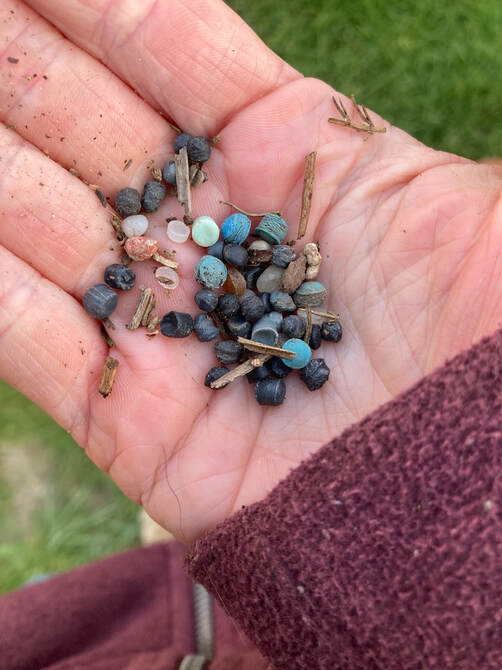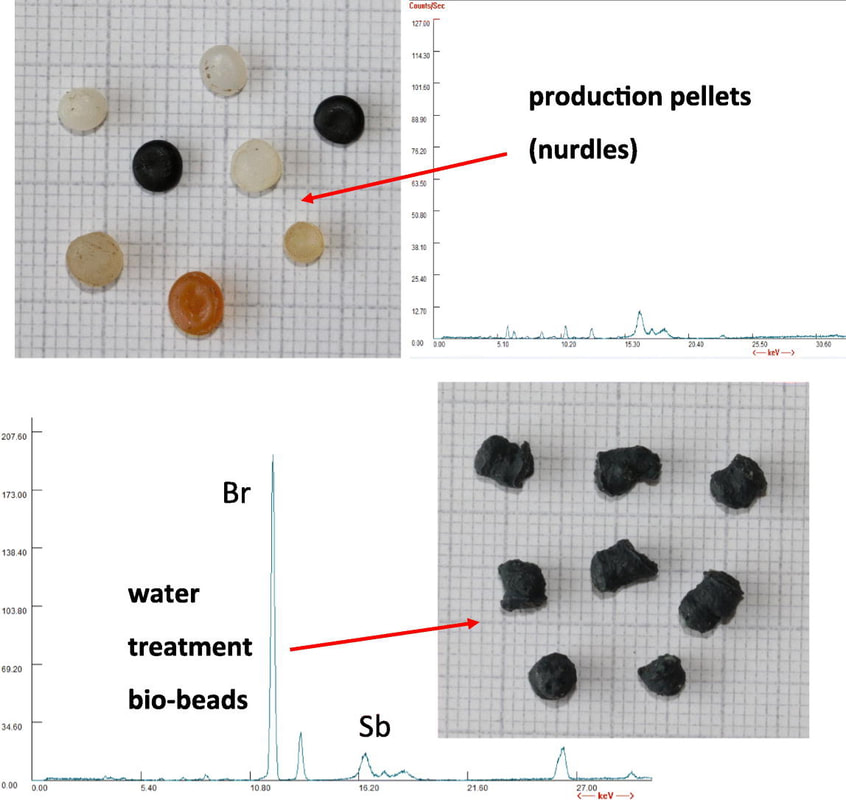NOw some GOOD news on nurdles at Charmouth
FIRST DEEP CLEAN FOR CHARMOUTH BEACHWeds - Sunday 24th − 28th January 2024
Pioneering beach clean experts, Nurdle, are in town for the last week in January. Whatever the weather, they’ll be working hard to remove the hundreds of thousands of plastic pellets that litter our shoreline and river mouth, using their range of ingenious machines. Read what you can do here.
Pioneering beach clean experts, Nurdle, are in town for the last week in January. Whatever the weather, they’ll be working hard to remove the hundreds of thousands of plastic pellets that litter our shoreline and river mouth, using their range of ingenious machines. Read what you can do here.
plastics on the beach
 Image: Dana Assinder
Image: Dana Assinder
Charmouth beach is littered with all sorts of waste including plastics of various kinds. Eden Thomson, a volunteer at the Charmouth Heritage Centre, highlighted the number of small plastic pellets among the waste and wrote about these “nurdles” for Shoreline Magazine in 2017. Stimulated by her article, writer and scientist, Philip Strange studied the Charmouth pellets and concluded that they were in fact a mixture of true nurdles (the raw material of plastic manufacturing) and biobeads (used by water companies in sewage purification). Since then, more and more people have become concerned about the plastic beads and other plastic waste found on Charmouth beach and the problem has even featured in the Western Morning News.
Knowing what the pellets are is one thing but finding where they come from is complicated. Two kinds of biobead appear at Charmouth, a black knobbly type and the predominant cylindrical blue ridged type. The black knobbly type looks similar to those found in large numbers on Tregantle Beach in Cornwall, shown by the Cornish Plastic Pollution Coalition to come from local sewage treatment plants run by South West Water. Philip, therefore, developed the hypothesis that the biobeads found at Charmouth were most likely being released into the sea along with treated sewage from the Lyme Regis Sewage Works at Sleech Wood, also run by South West Water.
In 2019, a group of environmentalists visited Sleech Wood Sewage Works. The visit was organised by Joe Hackett of Transition Town Bridport and the group found both black knobbly and ridged blue biobeads scattered about the site, strongly suggesting that biobeads used in sewage purification were being released into the sea along with purified sewage, leading to pollution of Charmouth Beach. Philip Strange also arranged for samples of the black biobeads from Charmouth to be analysed by Dr Andrew Turner at Plymouth University and they had a similar chemical signature to pellets found at Tregantle Beach linking both to South West Water.
In 2019, South West Water began a programme of installing extra containment at its biobead-dependent sewage works to stop losses of pellets. The pandemic may have delayed this programme.
On a visit to the sewage works in August 2022. South West Water confirmed that biobeads had previously escaped from the treatment plant into the sea outfall pipe (in at least one incident where the retaining screen broke). Taking all this background information together, it's clear that South West Water's Sleech Wood Sewage Works in Uplyme is very probably the source of the biobeads on Charmouth beach.
Here's what we know (based on Philip's research and on a detailed report by the Cornish Plastic Pollution Coalition, which is led by Claire Wallerstein).
You can read the summary below or check out the further reading section at the bottom.
See here for images from Dana Assinder's surveying of beach nurdles and biobeads on 29th June 2022
Now we have firm plans for the Nurdle Organisation to conduct an intensive clean-up operation in Spring 2024. Hurdle, the pioneering clean-up group, will be visiting on 24th-28th January and 10th-14th March 2024. See the full details of the plan here.
Knowing what the pellets are is one thing but finding where they come from is complicated. Two kinds of biobead appear at Charmouth, a black knobbly type and the predominant cylindrical blue ridged type. The black knobbly type looks similar to those found in large numbers on Tregantle Beach in Cornwall, shown by the Cornish Plastic Pollution Coalition to come from local sewage treatment plants run by South West Water. Philip, therefore, developed the hypothesis that the biobeads found at Charmouth were most likely being released into the sea along with treated sewage from the Lyme Regis Sewage Works at Sleech Wood, also run by South West Water.
In 2019, a group of environmentalists visited Sleech Wood Sewage Works. The visit was organised by Joe Hackett of Transition Town Bridport and the group found both black knobbly and ridged blue biobeads scattered about the site, strongly suggesting that biobeads used in sewage purification were being released into the sea along with purified sewage, leading to pollution of Charmouth Beach. Philip Strange also arranged for samples of the black biobeads from Charmouth to be analysed by Dr Andrew Turner at Plymouth University and they had a similar chemical signature to pellets found at Tregantle Beach linking both to South West Water.
In 2019, South West Water began a programme of installing extra containment at its biobead-dependent sewage works to stop losses of pellets. The pandemic may have delayed this programme.
On a visit to the sewage works in August 2022. South West Water confirmed that biobeads had previously escaped from the treatment plant into the sea outfall pipe (in at least one incident where the retaining screen broke). Taking all this background information together, it's clear that South West Water's Sleech Wood Sewage Works in Uplyme is very probably the source of the biobeads on Charmouth beach.
Here's what we know (based on Philip's research and on a detailed report by the Cornish Plastic Pollution Coalition, which is led by Claire Wallerstein).
You can read the summary below or check out the further reading section at the bottom.
See here for images from Dana Assinder's surveying of beach nurdles and biobeads on 29th June 2022
Now we have firm plans for the Nurdle Organisation to conduct an intensive clean-up operation in Spring 2024. Hurdle, the pioneering clean-up group, will be visiting on 24th-28th January and 10th-14th March 2024. See the full details of the plan here.
What can I do about microplastics?
- We are taking part in the Marine Conservation Society (MCS)'s Big Microplastic Survey. You can read more about it here. If you'd like to take part, we suggest you contact us first (by email to [email protected]) so we can help you find a stretch of the beach that is not already being monitored.
- Check the MCS Campaigns page for events that might interest you.
- Check the Preventing Plastic Pollution website - if you're interesting in setting up a local project, please contact us first to find out what else is happening in this area.
|
Microplastics
One of the most insidious forms of marine plastic pollution comes in the form of microplastics. Although plastic does not biodegrade, it does break down into smaller and smaller pieces in the sea. In the process it becomes more brittle through exposure to sunlight and through being smashed by the waves against sand and rock. Microplastics are pieces of plastic that are less than 5mm in size, meaning it is virtually impossible to remove from the environment. They are now found everywhere from the sea surface down to seabed sediments, and even locked into Arctic ice. They are also just the right size to be consumed by many sea creatures, particularly filter feeders. Shellfish, worms, crustaceans and coral all consume microplastics. The smallest pieces are even ingested by zooplankton, the foundation of the whole marine food chain. These plastic fragments cannot be digested and prevent sea creatures obtaining sufficient nutrition to thrive. They also attract toxins from the surrounding seawater, which accumulate in the animals’ body tissues. These can release a range of toxins which can damage the creatures' ability to reproduce, their nervous system and other functions. These effects are magnified further up the food chain in higher creatures that feed on these little ones, including commercial fish species. |
Nurdles
Plastics start out as nurdles - tiny pellets of plastic resin that are melted down and formed into all the plastic items we use. The nurdles seen on Charmouth Beach come in several forms: lentil-shaped pellets, translucent, white, yellow, green or smooth cylindrical pellets, pale blue or black. The number of nurdles made and shipped around the world each year is astonishing: over 100 billion kilos (5.5 quadrillion nurdles!) Large numbers end up in the sea, either because they are lost down drains in plastics factories, or are spilled from shipping containers. Unfortunately, nurdles look a lot like fish eggs – which form a large part of the diet of many marine creatures. In the UK, a voluntary industry scheme to prevent pellet loss called Operation Clean Sweep, encouraging companies to adopt measures to improve handling, transport and use of pellets, has been in place since 2009 - but very few companies have signed up to it! Rob Arnold, a member of Rame Peninsula Beach Care, invented a machine to help separate microplastics from sand and seaweed. In 2017 RPBC worked with Rob to collect many millions of nurdles, biobeads and other microplastics from Whitsand Bay, highlighting the plastic industry's contribution to the marine debris problem. The particles may be tiny, but numerically nurdles make up one of the biggest types of litter. |
Biobeads
As Philip Strange noticed back in 2017, a great many of the supposed nurdles on Charmouth beach are in fact biobeads - knobbly or ridged plastic pellets that are designed to have a larger surface area and are used in the wastewater treatment process. Biobeads are used in at least 55 wastewater plants around the country to filter sewage, with nine of these plants in the South West Water area. (Biobeads are used at the South West Water sewage treatment works in Lyme Regis. They are not used at the Charmouth treatment works - Wessex Water only use biobeads in two sewage treatment plants - neither of them on the south coast.) Biobeads account for over 50% of all the industrial pellets on Cornish beaches - we haven't got counts for West Dorset yet. They can escape from sewage treatment plants, either in large numbers through catastrophic spills, poor handling procedures, and through ongoing low-level losses. After many months of research, RPBC produced a report on behalf of the Cornish Plastic Pollution Coalition called Biobead pollution on our beaches. What we know so far (see below). We still don’t know enough about the pathways for losses (for example, they could also be lost through spills in transportation). However, it is clear that this system is too vulnerable, and there is no mechanism in place to effectively trap large numbers of beads in the event of a catastrophic spill. |
further reading
For Philip Strange's inspiring work, see his Marshwood Vale article and his own blog (where you can also read the Western Morning News article).
Philip's November 2022 blog
Eden Thomson's article in Shoreline (it's on p.29)
NurdleNerd - a great introduction
Clean Jurassic Coast - more technical
Rame Peninsula Beach Care/Cornish Plastic Pollution Coalition - their 70-page report is packed with detail
Philip's November 2022 blog
Eden Thomson's article in Shoreline (it's on p.29)
NurdleNerd - a great introduction
Clean Jurassic Coast - more technical
Rame Peninsula Beach Care/Cornish Plastic Pollution Coalition - their 70-page report is packed with detail
